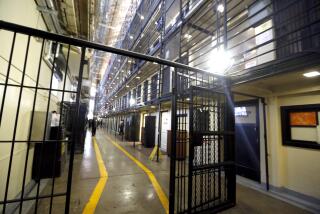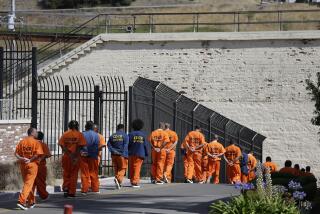California bans for-profit prisons and immigrant detention facilities

In his latest rebuke of the Trump administration, Gov. Gavin Newsom signed a bill Friday that bans private prisons and immigrant detention facilities from operating in California.
Assembly Bill 32 will prevent the state from entering into or renewing contracts with for-profit prison companies after Jan. 1, 2020, and phase out such facilities by 2028. The bill earned final approval from the Assembly on Sept. 11 by a vote of 65 to 11, a day after it cleared the Senate.
The move, hailed as a major victory by advocates for criminal justice reform and immigrant rights, lets Newsom fulfill a promise to “end the outrage that is private prisons in the state of California once and for all.”
Private prisons are a multibillion-dollar industry in the U.S. and are currently operating in 27 states. Though they hold less than 9% of all state and federal prisoners, the vast majority of immigrants detained for deportation are held in for-profit facilities.
The California Department of Corrections and Rehabilitation contracts with the Florida-based GEO Group to run four private prisons in Kern and San Bernardino counties that can hold up to 2,400 inmates. Those contracts will expire by June 2023 and can’t be renewed or extended under the new law except to comply with a court-ordered population cap to reduce overcrowding in public facilities.
As of Sept. 11, there were 114,800 state prisoners in custody — about 2,200 below the cap imposed on California by federal judges in 2009. Nearly 1,700 of those inmates were held in the private facilities.
A GEO Group representative suggested that the law, especially the ban against immigrant detention facilities, could be struck down by the courts.
“States cannot lawfully pass legislation mandating the closure of federal facilities that displease them on the basis of ideological differences,” the representative said.
AB 32 was written by Assemblyman Rob Bonta (D-Alameda), who pushed a similar measure in 2017. But that bill was vetoed by then-Gov. Jerry Brown, who said that the state needed to “maintain maximum flexibility in the short term” in order to comply with the population cap. Bonta called Friday’s signing a historic moment.
“By ending the use of for-profit, private prisons and detention facilities, we are sending a powerful message that we vehemently oppose the practice of profiteering off the backs of Californians in custody, that we will stand up for the health, safety and welfare of our people, and that we are committed to humane treatment for all,” he said.
The change could cost California more than $100 million a year, according to Senate Appropriations Committee findings. This fiscal year, the average cost per inmate in a state prison is nearly $85,000, while for a private prison the cost is only about $31,000 per inmate. Critics, including Bonta, have said that’s because private companies find ways to cut corners.
At the height of prison overcrowding in 2006, California had more than double the number of inmates than its prisons were meant to hold. Dependence on private facilities increased four years later after a federal court ruled that the state was violating inmates’ constitutional rights and ordered leaders to reduce the prison population to no more than 137.5% of design capacity. As a partial remedy, California paid to house some inmates in private lockups, county jails and even in neighboring states.
Since then, legislative reforms and policy changes have reduced the number of prisoners in California, decreasing reliance on private prisons. Realignment moved certain low-level offenders to county jails, and the 2016 ballot measure Proposition 57 made it easier for some nonviolent inmates to seek parole. The last California inmates held in out-of-state facilities were transferred back in June.
California isn’t the only state to ban private prisons. In June, Illinois became the first state to ban private immigration detention facilities — preventing the construction of a 1,300-bed facility outside Chicago. In 2016, then-President Obama moved to end the use of private prisons for federal inmates (not including immigrant detainees), but the Trump administration later reversed the decision.
But the new law doesn’t fully shut for-profit prison companies out of California. Private companies manage federal prisons and city jails, as well as substance abuse treatment centers, transitional housing and parole services. CoreCivic also owns the 2,300-bed California City Correctional Facility in Kern County, which isn’t affected by AB 32 because the state manages the prison itself.
Among the opponents of AB 32 was the California State Sheriffs’ Assn. The group said in a statement that keeping the prison population under the court-ordered cap remains a challenge and that an influx of new, serious offenders will place more pressure on county jails.
“We are exceedingly concerned about hamstringing state prison officials,” the sheriffs group said.
AB 32 started out as a ban on private prisons, but Bonta amended the bill in June to expand the ban to immigration detention centers. Immigrant advocates have long spoken out about abuses in those facilities. A review by the Department of Homeland Security’s inspector general found that U.S. Immigration and Customs Enforcement rarely holds contractors accountable for failing to meet performance standards. Investigators found 14,000 health and safety “deficiencies” during various inspections at contracted facilities between October 2015 and June 2018.
“These deficiencies include those that jeopardize the safety and rights of detainees, such as failing to notify ICE about sexual assaults,” the inspector general found. “Despite these identified deficiencies, ICE only imposed financial penalties twice.”
Compared with the 51,000 people currently in ICE custody nationwide, California represents less than 8% of the agency’s capacity. In Louisiana alone, ICE added 7,500 beds this year in response to the crisis on the southwest border.
Spokesman Bryan Cox said ICE would continue to detain people regardless of any states’ decisions.
“ICE would simply have to transfer individuals a greater distance from their arrest location,” he said. “The greatest impact would be felt by California residents, who would be forced to travel longer distances to visit friends and family in detention.”
Advocates of AB 32 say that ICE is promoting a false narrative because the agency could choose to simply release many immigrants in its custody and utilize alternatives to detention, such as ankle monitors and telephonic or ICE office check-ins, to ensure that they show up for court hearings.
With 1,940 beds, the Adelanto ICE Processing Center near Victorville in San Bernardino County is the second-largest adult detention center in the country. The GEO Group runs Adelanto and the Mesa Verde ICE processing facility near Bakersfield.
Tennessee-based CoreCivic runs the Otay Mesa Detention Center in San Diego, while the Utah-based Management & Training Corp. operates the Imperial Regional Detention Facility in Calexico. Together, the four facilities can hold nearly 4,000 detainees.
GEO Group and CoreCivic spent a combined $160,000 lobbying against AB 32, according to reports filed with the California secretary of state.
CoreCivic is planning a 500-bed expansion of the Otay Mesa facility by the end of this year, which would bring it to 1,408 beds. Spokeswoman Amanda Gilchrist described the company’s role as helping the government manage humanitarian crises, improving standards of care for vulnerable populations and meeting critical public safety needs.
“When California’s prison system capacity was at 200% and conditions were so challenging as to be deemed unconstitutional, companies like ours were one of the solutions the state turned to,” she said. “Attempts to eliminate options for other governments in crisis are misguided.”
A pair of California laws passed in 2017 aimed to block the expansion of immigration detention facilities in the state by prohibiting local governments from establishing new contracts with for-profit prison companies and ICE, or expanding existing ones.
Until recently, three of the private facilities in California were operated through contracts that use nearby cities as middlemen between ICE and the companies that operate them. McFarland, Adelanto and Holtville bowed out of those contracts this year.
But because of the complexities of contract law, those moves could have resulted in more immigrants in detention by making it easier for ICE to go directly into business with the private prison companies and sidestep those 2017 laws. AB 32 ensures that won’t happen.
Adelanto and McFarland pulled out of their contracts this year. The Mesa Verde and Adelanto centers remain open under temporary one-year “bridge” contracts.
The city of Holtville recently ended its contract with ICE and Management & Training Corp. overseeing the management of the Imperial Regional facility. The new one-year contract went into effect last month and expires in September 2020, which means it should be the last California immigrant detention facility to close under AB 32.
Otay Mesa is run by CoreCivic under a direct contract with ICE that is set to expire next June.
Christina Fialho, co-founder of the California-based group Freedom for Immigrants, which advocates for the abolition of immigrant detention facilities, said she’s happy to see that ICE and private prison companies will be prevented from “undermining” state laws in order to expand detention centers. The nonprofit launched an emergency fund Friday to pay for immigration bonds and support families affected by detention center closures.
“AB 32 is the most progressive and far-reaching bill on immigration detention in this country,” she said. “We hope to see other states and Congress follow our lead.”
More to Read
Start your day right
Sign up for Essential California for news, features and recommendations from the L.A. Times and beyond in your inbox six days a week.
You may occasionally receive promotional content from the Los Angeles Times.






